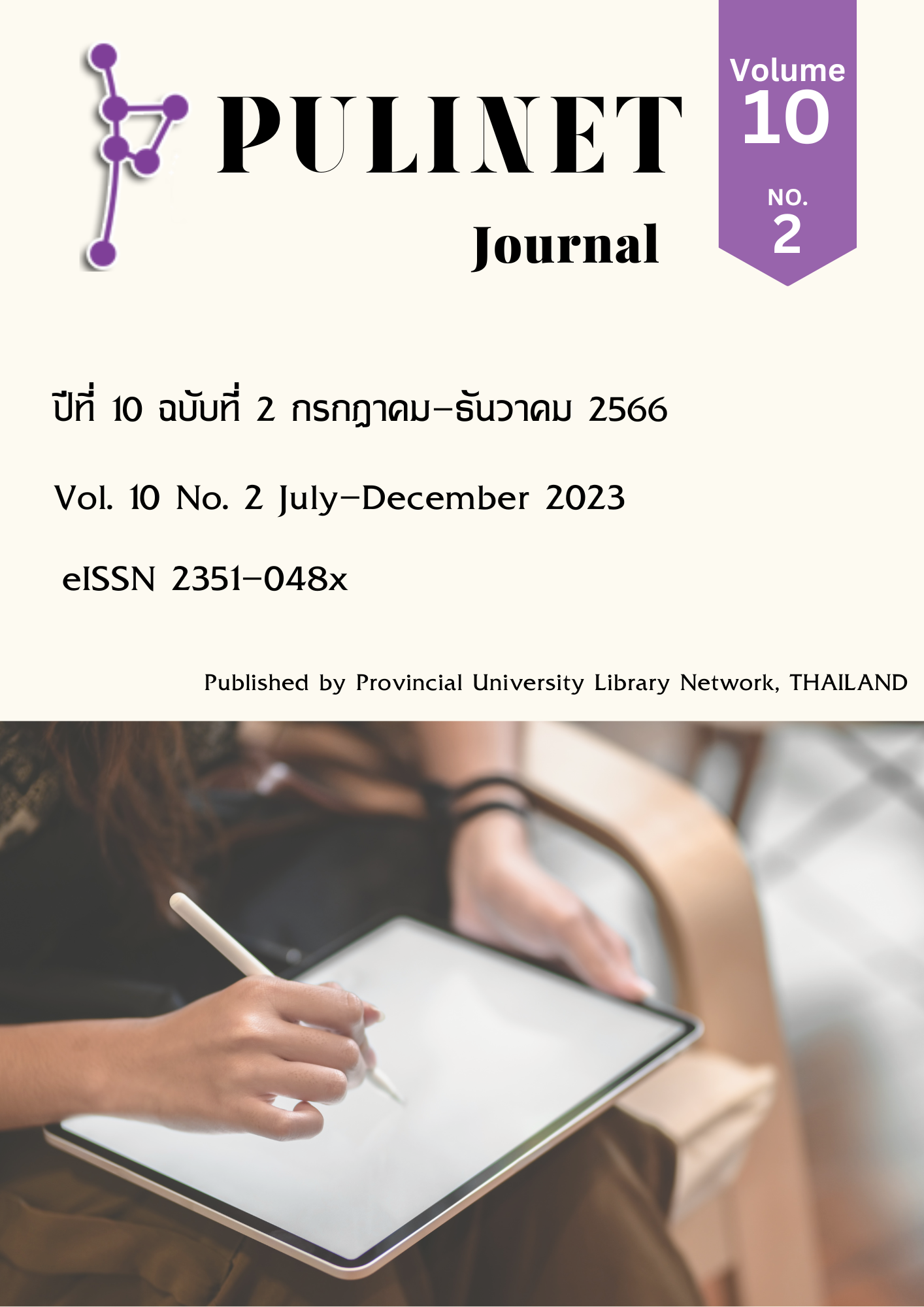การประยุกต์ใช้เกมมิฟิเคชันเพื่อส่งเสริมการใช้บริการและทรัพยากรสารสนเทศ หอสมุดแห่งมหาวิทยาลัยธรรมศาสตร์
Main Article Content
บทคัดย่อ
เมื่อเทคโนโลยีดิจิทัลได้เข้ามามีบทบาทในการใช้ชีวิตของผู้คนในสังคมยุคปัจจุบัน ที่ผ่านมาหอสมุดแห่งมหาวิทยาลัยธรรมศาสตร์ได้ปรับเปลี่ยนกระบวนการทำงานเพื่อให้เท่าทันกับสังคม พัฒนาการบริการให้มีมาตรฐานระดับสากล รองรับการเรียนรู้ทุกที่ทุกเวลา มีทรัพยากรสารสนเทศและบริการหลากหลาย ทั้งในรูปแบบสื่อสิ่งพิมพ์ สื่ออิเล็กทรอนิกส์ วัสดุอุปกรณ์ (Library of Things) และบริการพื้นที่เพื่อส่งเสริมการเรียนรู้ของประชาคมธรรมศาสตร์ นอกจากนี้ หอสมุดฯ ได้พัฒนา TULIB Gamification เพื่อนำมาเพิ่มประสิทธิภาพในการให้บริการ ซึ่งได้นำองค์ประกอบและหลักการออกแบบเกม มาปรับใช้ในบริบทที่ไม่ใช่เกม ซึ่งแนวคิดนี้เรียกว่า เกมมิฟิเคชัน (Gamification) โดยพัฒนาระบบซึ่งเชื่อมต่อกับไลน์แอปพลิเคชันที่สามารถโต้ตอบกับผู้ใช้บริการเมื่อมีปฏิสัมพันธ์กับทางหอสมุดฯ ออกแบบให้มีการสะสมคะแนน เลื่อนระดับ และการถูกท้าทายจากภารกิจ เพื่อกระตุ้น สร้างแรงจูงใจให้เกิดการมีส่วนร่วมอย่างต่อเนื่อง เพิ่มความสนุกสนานให้ผู้ใช้บริการของหอสมุดฯ มากขึ้น โดยกลุ่มเป้าหมาย คือ นักศึกษาทุกระดับชั้น อาจารย์ และบุคลากร โดยใช้เครื่องมือในการวิจัย คือ แบบประเมินความพึงพอใจกิจกรรม TULIB Gamification จากผลการดำเนินการ ตั้งแต่วันที่ 13 มิถุนายน - 13 ตุลาคม 2565 พบว่าผู้ใช้บริการมีความพึงพอใจโดยรวม ที่ร้อยละ 93.90 มีผู้ใช้บริการหน้าใหม่ฯ (New Active User) เพิ่มขึ้นอยู่ที่ร้อยละ 74.86 และจากการประเมินความพึงพอใจโดยผู้ใช้บริการจริง ร้อยละ 94 จะแนะนำ TULIB Gamification ให้เพื่อน คนรู้จัก จึงถือว่าการนำเกมมิฟิเคชันมาประยุกต์ใช้กับการให้บริการของหอสมุดฯ ประสบความสำเร็จในการให้บริการจากการสร้างนวัตกรรมบริการตามแผนยุทธศาสตร์หอสมุดฯ ปี 2565 (S-Smart Library) โดยสามารถพัฒนาประสบการณ์การเรียนรู้ของผู้ใช้สร้างความพึงพอใจในบริการและส่งเสริมภาพลักษณ์หอสมุดฯ ยุคใหม่มากยิ่งขึ้น
Article Details

อนุญาตภายใต้เงื่อนไข Creative Commons Attribution-NonCommercial-NoDerivatives 4.0 International License.
เอกสารอ้างอิง
กัลยา ตันติยาสวัสดิกุล. (2565). กระบวนการคิดเชิงออกแบบสำหรับการแก้ปัญหาอย่างสร้างสรรค์. บริษัท คอร์ปอเรชั่น โฟร์ดี จำกัด.
ตรัง สุวรรณศิลป์. (2564). Gamification เกมมิฟิเคชัน จูงใจคนด้วยกลไกเกม. ซอลท์.
พันธวัฒน์ เศรษฐวิไล. (2564). “ห้องสมุดจะไม่ตาย ก็ต่อเมื่อมันกลายเป็นส่วนหนึ่งของวิถีชีวิต” ชาตรี ประกิตนนทการ. TheKommon. https://www.thekommon.co/chatri-prakitnonthakan-library/
วัจนภร น้อยเลิศ. (2556). บรรทัดฐานทางสังคม แรงจูงใจด้านความบันเทิงและความพึงพอใจในเกมมิฟิเคชันที่มีอิทธิพลต่อการสร้างความผูกพันในแบรนด์. [วิทยานิพนธ์ปริญญามหาบัณฑิต]. มหาวิทยาลัยธรรมศาสตร์.
Bunchball, I. (2010). Gamification 101: An Introduction to the Use of Game Dynamics to Influence Behavior. http://www.bunchball.com/sites/default/files/downloads/gamification101.pdf
Fang, C., & Wu, K. (2022, July 6-8). Development of a Children's Library Application with Gamification Elements to Enhance the Intrinsic Motivation. 2022 IEEE International Conference on Consumer Electronics – Taiwan.
Felker, K., & Phetteplace, E. (2014). Gamification in Libraries: The State of the Art. Reference & User Services Quarterly, 54(2), 19-23. http://www.jstor.org/stable/refuseserq.54.2.19
Giddens, D. (2016). Game it up! Using gamification to incentivize your library. The Australian Library Journal, 65(4), 330-330. https://doi.org/10.1080/00049670.2016.1241204
Keiser, B. E. (2022). THE GAME IS ON: Gamifying Library Instruction, Usage, and Career Advancement. Online Searcher, 46(4), 10-15. https://search.ebscohost.com/login.aspx?direct=true&AuthType=ip,sso&db=ccm&AN=157840249&site=eds-live&scope=site&custid=s4775581
Yu-TeTu, Y.-T., & Tan-Kui, H. (2013). The Impact of Brand Image and Customer Commitment on Loyalty: An Empirical Study of Automobile Sector. Information Management and Business Review, 5(4), 181-193. https://doi.org/10.22610/imbr.v5i4.1042


